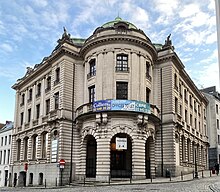
NatWest Group plc is a British banking and insurance holding company, based in Edinburgh, Scotland. The group operates a wide variety of banking brands offering personal and business banking, private banking, investment banking, insurance and corporate finance. In the United Kingdom, its main subsidiary companies are National Westminster Bank, Royal Bank of Scotland, NatWest Markets and Coutts. The group issues banknotes in Scotland and Northern Ireland; as of 2014, the Royal Bank of Scotland was the only bank in the UK to continue to print £1 notes.

Ulster Bank is a large retail bank, and one of the traditional Big Four Irish clearing banks. The Ulster Bank Group was subdivided into two separate legal entities: National Westminster Bank Plc, trading as Ulster Bank ; and, until April 2023, Ulster Bank Ireland DAC. Prior to the closure of Ulster Bank in the Republic of Ireland in April 2023, the headquarters of Ulster Bank in the Republic of Ireland were located on George's Quay, Dublin, whilst the headquarters of Ulster Bank Northern Ireland are in Donegall Square East, Belfast, and it maintains a large sector of the financial services in both the UK and the Republic of Ireland.
TD Banknorth, formerly Banknorth, was a wholly owned subsidiary of the Toronto-Dominion Bank which conducted banking and insurance activities, primarily serving the northeastern area of the United States, headquartered in Portland, Maine. The bank became TD Bank, N.A. on May 31, 2008.

National Provincial Bank was a retail bank which operated in England and Wales. It was created in 1833 as National Provincial Bank of England, and expanded largely by taking over a number of other banks. Following the transformative acquisition of Union Bank of London in 1918, it changed its name to National Provincial and Union Bank of England, then in 1924 shortened its name again to National Provincial Bank. It further acquired Coutts Bank in 1920, Grindlays Bank in 1924, Isle of Man Bank in 1961, District Bank in 1962, thus becoming one of the "Big Five" that dominated the UK banking sector for much of the 20th century, together with Barclays Bank, Lloyds Bank, Midland Bank and Westminster Bank. On 1 January 1970, it completed its merged with Westminster Bank to form National Westminster Bank.
Lombard North Central, trading as Lombard, is a finance company specialising in asset based lending. It is one of the largest finance houses in the United Kingdom and part of the ring-fenced business of NatWest Group. The company started life hiring out rolling stock to the railways in 1861.

The Royal Bank of Scotland plc is a major retail and commercial bank in Scotland. It is one of the retail banking subsidiaries of NatWest Group, together with NatWest and Ulster Bank. The Royal Bank of Scotland has around 700 branches, mainly in Scotland, though there are branches in many larger towns and cities throughout England and Wales. The bank is completely separate from the fellow Edinburgh-based bank, the Bank of Scotland, which pre-dates the Royal Bank by 32 years. The Royal Bank of Scotland was established to provide a bank with strong Hanoverian and Whig ties.

Messrs Drummond is a formerly independent private bank in the United Kingdom that is now part of NatWest Group. The Royal Bank of Scotland incorporating Messrs Drummond, Bankers is based at 49 Charing Cross in central London. Drummonds is authorised as a brand of The Royal Bank of Scotland by the Prudential Regulation Authority.
The Isle of Man Bank is a bank in the British Crown dependency of the Isle of Man, providing retail, private and business banking services to the local population. Incorporated in 1865, it has operated as a trading name of RBS International since 2019. It is licensed by the Isle of Man Financial Services Authority in respect of deposit taking and investment business and registered as a general insurance intermediary.

The Manchester and Liverpool District Bank was formed in 1829 and it became one of the leading provincial joint stock banks; its name was shortened to District Bank in 1924. The Bank was acquired by the National Provincial Bank in 1962 but kept its identity until the latter’s merger with Westminster Bank.

Parr's Bank Limited was a bank that existed from 1782 to 1918. It was founded as Parr & Co. in Warrington, then in the county of Lancashire in the United Kingdom. In 1918 it was acquired by London County and Westminster Bank, and it was thus one of the predecessors of NatWest Group.
Williams & Glyn's Bank Limited was established in London in 1970, when the Royal Bank of Scotland merged its two subsidiaries in England and Wales, Williams Deacon's Bank Ltd. and Glyn, Mills & Co. In 1985, Williams & Glyn's was fully absorbed into the Royal Bank of Scotland and ceased to trade separately.

National Westminster Bank, commonly known as NatWest, is a major retail and commercial bank in the United Kingdom based in London, England. It was established in 1968 by the merger of National Provincial Bank and Westminster Bank. In 2000, it became part of The Royal Bank of Scotland Group, which was re-named NatWest Group in 2020. Following ringfencing of the group's core domestic business, the bank became a direct subsidiary of NatWest Holdings; NatWest Markets comprises the non-ringfenced investment banking arm. The British government currently owns 39% of NatWest Group after spending £45 billion bailing out the lender in 2008; the proportion at one point was 54.7%. NatWest International is a trading name of RBS International, which also sits outside the ringfence.

International Westminster Bank was a wholly-owned subsidiary of National Westminster Bank and its predecessors from 1913 to 1989, with branches in London, France, Spain and West Germany.
Williams & Glyn was a division of The Royal Bank of Scotland (RBS) and National Westminster Bank (NatWest) consisting of 307 RBS branches in England and Wales and NatWest branches in Scotland. The division was formed because the then RBS Group, owner of the two banks, was required by the European Union (EU) to divest a portion of its business after HM Government took an 84% stake in the group during the 2008 United Kingdom bank rescue package, which the EU classed as state aid. RBS Group was required to divest Williams & Glyn by the end of 2017.
Lloyds and National Provincial Foreign Bank Limited was a joint venture in France between London-based Lloyds Bank and National Provincial Bank, which existed from 1917 to 1955.
National Westminster Bank USA, commonly known as NatWest USA, was a wholly owned subsidiary of National Westminster Bank in the United Kingdom from 1983 to 1996. Formed as the National Bank of North America in 1905, the U.S. retail banking operation was sold to Fleet Financial Group in 1996.
Holt's Military Banking is a trading name of The Royal Bank of Scotland, a subsidiary of NatWest Group, offering dedicated banking facilities to service personnel in the United Kingdom and on operational tours of duty overseas. It can trace its origins to a Mr. Vesey, army agent to the 23rd Regiment of (Light) Dragoons, in Dublin in 1802.

NatWest Markets is the investment banking arm of NatWest Group based in the United Kingdom.
Fuller, Banbury, Nix & Co was a British private bank based in the City of London. It was founded in 1737 in Lombard Street, London and operated under a succession of names reflecting its different partners until receiving its final name in 1881. One of the bank's partners, John Hennings Nix, was the second great-grandfather of Alexander Nix. The bank had a seat on the London Bankers' Clearing House. In 1891 the bank was acquired by Parr's Banking Co Ltd of Warrington, thus facilitating the bank's expansion into London. Through merger with London County & Westminster Bank in 1918, it became a constituent part of the modern NatWest.















